This is the first in a (hopefully) long set of posts about our summer trip to Tanzania.
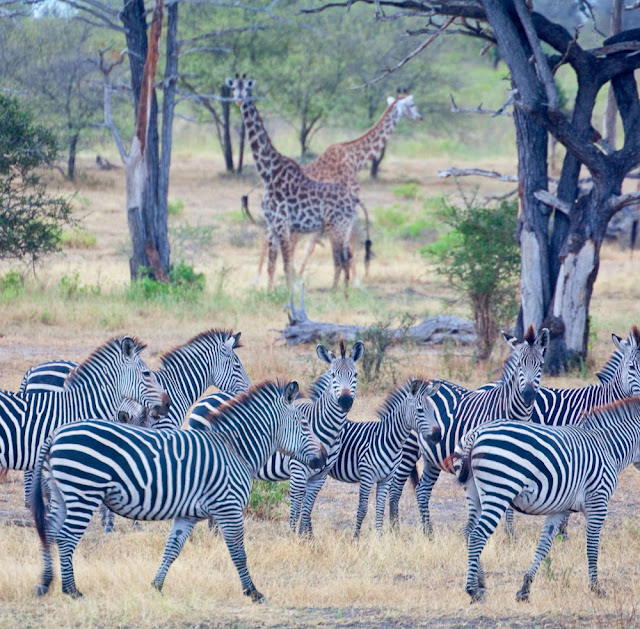.jpg)
I can't remember why we settled on Tanzania as our destination, but now that we're back and have the memories and photos from our journey, I'm very happy that we picked it. It's a beautiful country all right, with the lakes of the south, the great rift valley, the Ngorongoro crater, Kilimanjaro, the Serengeti plain and the beaches and coral of Zanzibar. The animals are plentiful and you can see and photograph just about any African animal on your list except for kangaroos (inside joke with our guide). But, Tanzania is special to me because of its people. The people certainly aren't the richest in the world by monetary standards, but they live in peace and seem genuinely happy to see you. There are well over 100 tribes who live in harmony and share a common language (Swahili) thanks to their first Prime Minister. It sometimes gives me great pleasure to search Google news for items on Tanzania because usually there is very little to report. People go about their daily lives, tourists come and go and the news media is blissfully free of murders, terrorist attacks and reports of piracy. The scenery and abundant animals are the icing on the cake.
We embarked on our journey on the eve of Canada Day and flew to Dar es Salaam via Amsterdam. To make this journey, one must ride in two large aluminum tubes for about 16 hours with a stopover in Schipol airport. Make sure you bag one of the lovely reclining chairs in the terminal so you can nap in between flights. There are people who get off at Kilimanjaro with their backpacks full and their eyes set on climbing the mountain. We were more interested in seeing the wildlife and the people, so we gave Kili a pass and landed at Dar. By the time we bought our visas and cleared customs, it was close to midnight and we were very happy to see our beds in the downtown hotel, especially since we were heading back out early the next morning.
Before I resume my narrative, let me tell you a little about the travellers. There are four of us who often travel together. Rick and Deb are wonderful friends and travelling companions. Rick is a mining engineer who has found a career as an environmental consultant. He knows dirt. If you have land that has troublesome soil pollution, Rick will be happy to charge you a lot of money to advise you. Usually his advice means putting the troublesome dirt into a dump truck and making it somemone else's problem. You can't vaporize dirt! Deb is a world-renowned child psychologist and expert on bullying. Usually we manage to time our adventures around one of Deb's conferences and she was going to be speaking in Zambia after our trip. My wife, Trish, is an associate dean of a college in Toronto. In her job, she gets to deal with hiring teachers, mapping out strategy for her department and advising young adults who are usually under achieving and looking for help. Trish keeps a box of Kleenex and a bag of candy nearby to comfort them - she is a very kind person. I'm the narrator and I'm also a consultant. I advise people on how to design large computer systems. In my spare time, I like to take photographs. Lots of photographs!
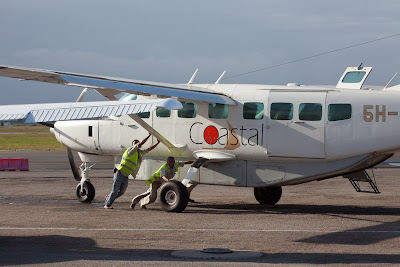.jpg)
We were up before dawn and heading back out to the airport. Dar airport is has a dual personality. On one side, there is the International airport with proper air bridges for the big international jets. On the other side, there is the domestic terminal, a throwback to the 50's with a bustling waiting room and small prop planes coming and going. We flew out with a handful of others in a Cessna Caravan turbo prop that seats 12. This plane, as we were to find out, is the workhorse of Tanzania. The domestic fleet is probably half Caravans and half everything else under the sun. The Caravan is a super plane - it's comfortable and fast and can land on the many gravel landing strips that dot the country.
If you look at a map of Tanzania, you can see that our destination, Selous National Park, is not all that far from Dar es Salaam. Why, you might ask, didn't we drive or take a bus? The answer is simple. Tanzanian roads are a disaster. Almost none of the roads are paved outside of the cities and the surfaces are a dusty, bumpy mixture of sand and gravel that make even short journeys take all day. A 40 minute flight to Selous beats a 10 hour sojourn over back-breaking rutted backroads.
As we left Dar, we flew over the remains of plantations and eventually reached green bush land. Soon, we caught sight of lakes in the distance and the pilot dropped down so that we can see wildlife. We spotted our first giraffes and wildebeests and then we realized that we are on our final approach. The animals were hanging out in the woods right beside the air strip. Our lives were hanging on the zebras, giraffes and elephants staying put in the trees and not deciding to cross the runway while we happened to be using it.

Fortunately we made it down safely and were met by our guide and driver in an open Toyota Land Cruiser. Our guide, Emmanuel, is a handsome young lad who has an encyclopedic knowledge of the birds and animals and can spot an elephant miles away. We made our way slowly to our destination, Lake Manze Camp, catching sight of our first African animals. We were saucer-eyed as we spotted herds of impala, zebra, wildebeest, giraffes and even elephants and lions. Here's a photo of a male impala...

We reached our tented camp and were delighted with the reception. Our host and camp director, Richard, turned out to be an ex-Buddist monk who discovered an affinity for guiding and is now managing Lake Manze camp. He gave us a very nice welcome and gave us a tour of the central eating area and then ushered us to our tents, accompanied by our Masai warrior guards. We were a little non-plussed that we needed guards, but later found out why. Our tents turned out to be very comfortable, with a large sleeping area, wooden bed, stone patio for reading and a toilet and shower with running water (cold and hot!).

Here are Rick and Deb standing outside their Lake Manze Camp tent...
Lake Manze camp is a little off the beaten track. Many people come to Tanzania and climb Kili or tour the Serengeti and the Ngorongoro crater, but few venture south to Selous and it is their loss. Selous has several advantages that make it a "must do": it isn't crowded, the park rules allow you to venture off-road and there are wonderful water safaris that let you get close to the crocs, hippos and the birds.
The elephants are very plentiful in Lake Manze camp and they tend to get very close and personal. On our first night, we had a splendid meal under the stars. Richard sat at the head of a very large table and all the camp guests enjoyed each others' company seated at the big table. After dinner, Rick and I went to the bar for a nightcap while Trish and Deb went back to the tents with the requisite Masai guards. While they were getting ready for bed in their tents, the ladies heard a huge crash just outside Deb's tent. She looked out of the window and saw an elephant walking right by the tent. Deb and Trish had visions of elephants trampling down the tents, but they seemed to be content to mill about eating the undergrowth. When Rick and I got back to our tents, we were greeted by quite a story!

One of our fellow guests turned out to be a very accomplished professional photographer,
Donald Miralle. Donald is now independant, but used to work for Getty. He does a lot of sports photography and was in Tanzania on assignment for National Geographic where he would be photographing a medical mission. Technically, he was on holiday during his stay at Selous, but he worked as hard as anyone I've seen. He photographed from morning to night and was often in the next boat to us on the river. He had wonderful equipment: three Canon bodies and several nice lenses including a huge 400mm f2.8 bazooka that looked like it took two people to carry.
We had many great safaris during our three days at Selous. The river cruises were absolutely fabulous. We usually started around 4 in the afternoon and went up and down the river in the little tin boat with our guide Elton until the sun set. The sun would get low on the horizon and the light turned a golden colour. We saw hundreds of crocodiles lurking on the side of the river. As we motored by, the crocs would startle and launch themselves into the water until all we could see were their eyes. We also saw many pods of hippos lazing in the river. The hippos didn't like being disturbed and one of them would usually charge our boat as we stopped to watch them. The guide would watch for bubbles approaching our boat and would move off before the hippo could approach. Hippos are very aggressive and kill more humans than any other African animal. Occasionally we would see other animals in the mud flats beside the river including water buffalo and elephants. At one point, we were just leaving the dock and heading down into the main estuary when a pair of elephants decided to cross the river right in front of us.
.jpg)
The highlight of the Selous river safari was the bird life. You can see every type of stork and heron imaginable and lovely bee catchers and Kingfishers.


Occasionally, you can also see a sea eagle sitting majestically on a palm tree stump lit up by the golden light of the sunset.

Elton's favorite trick was to run the boat down a bank where there were thousands of bee catcher nests burrowed into the mud. As the boat went down the row of nests, the birds all flew out by the thousands. When we had passed, the birds returned to their nests and many would strike a pose on the branches over the mud bank with their vivid plumage lit up by the sun.
.jpg)
Our jeep safaris were just as good. On one occasion, our guide Emmanuel spotted buzzards in a tree in the distance. In most northern parks, you would have to find a road near the tree, but we just struck off the road and travelled overland towards the buzzards. When we got close, we spotted a trio of lionesses who had recently killed a wildebeest. One of the lions was having a lovely nap with its paw in the air. The other two were chowing down on the carcass while the buzzards looked on. After watching the feast for a half hour we moved on. We came by the scene later the next day and all that was left of the wildebeest was its skeleton.

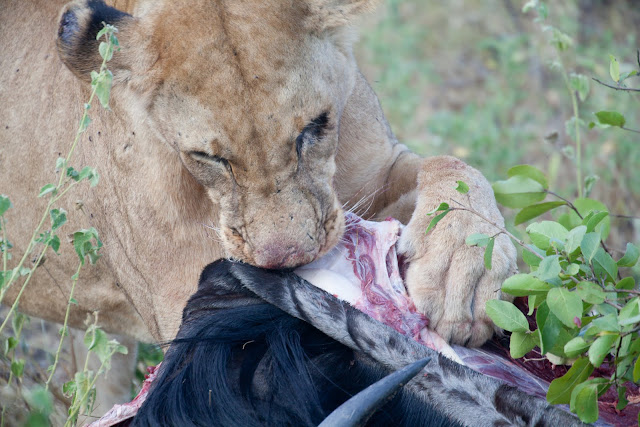.jpg)
On another safari, we were driving towards a pride of lions who were dozing under a tree. Our driver pointed the jeep at the tree and started to drive towards it. Unfortunately, there was a muddy stream in the way and we got stuck in the stream before we could approach the lions. There was another Lake Manze jeep in the vicinity and they were able to pull us to safety, but we had to get out of the jeep to lighten the load. It was a strange feeling standing there with lions in the distance.
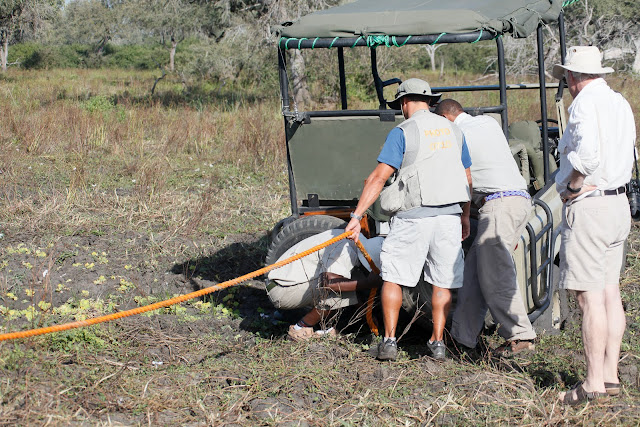.jpg)
Here's Don Miralle, professional photographer and amateur tow truck driver helping to get us out of the mire. The lions are lying under the trees visible in the background.
In Selous, you can also do a walking safari. Early in the morning, we headed out with our guide and a guard who was carrying an automatic rifle. Clearly, they were taking our safety very seriously this time! We had a pleasant hike in the bush and saw a very large family of elephants as well as giraffes and baboons. Here is our walking safari guard.
.jpg)
After Selous, it was time to make our way to Arusha and the north. Our pilot had arrived the night before and we had a pleasant dinner with him. He was a very young man, originally from South Africa, who was very keen to start his career as a pilot. Early the next morning, we drove out to the air strip with him and were a little taken aback when we spotted our ride for the morning. It was a very small airplane, a Cessna 206 that seated 6. The airplane was sitting at the end of the landing strip and the wheels were covered in thorns to stop the animals from eating the tires! The take-off was very loud, but the flight was very smooth in the still morning air and we had an excellent view of the Selous lake country as we turned towards Dar.
.jpg)
I'd wondered why our itinerary had reserved four hours for the flight from Selous to Dar, but it turned out that we flew from Selous to Dar, Dar to Zanzibar and Zanzibar to Arusha with layovers in between. Sometimes you just have to go with the flow.

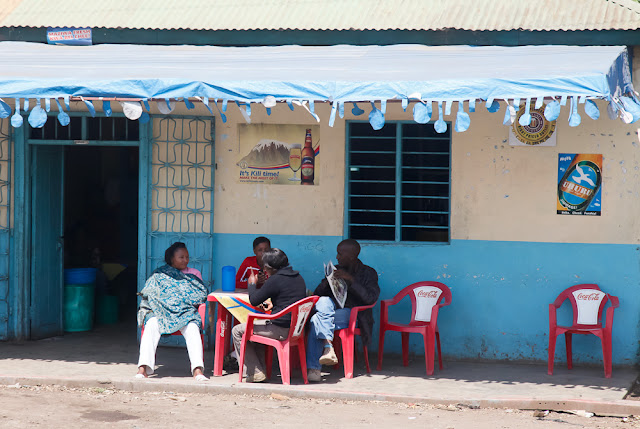









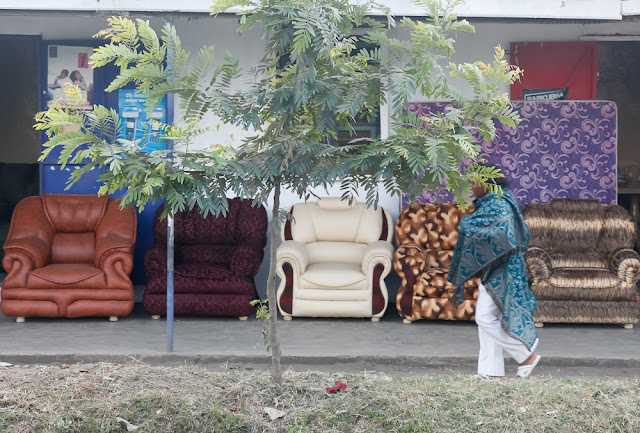



















.jpg)
.jpg)







.jpg)



.jpg)

.jpg)
.jpg)
.jpg)
.jpg)